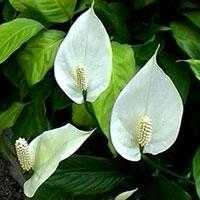Indoor plants found to release volatile organic compounds - Radiocápsula RCP/CPR
Submitted on 7 September 2009 - 7:41pm
This article is reproduced by CienciaPR with permission from the original source.

Eurekalert - Potted plants add a certain aesthetic value to homes and offices, bringing a touch of nature to indoor spaces. It has also been shown that many common house plants have the ability to remove volatile organic compounds—gases or vapors emitted by solids and liquids that may have adverse short- and long-term health effects on humans and animals—from indoor air. But take heed when considering adding some green to your environment; in addition to giving off healthy oxygen and sucking out harmful VOCs, a new study shows that some indoor plants actually release volatile organic compounds into the environment.
A research team headed by Stanley J. Kays of the University of Georgia's Department of Horticulture conducted a study to identify and measure the amounts of volatile organic compounds (VOCs) emitted by four popular indoor potted plant species. The study, published in the American Society for Horticultural Science journal HortScience, also noted the source of VOCs and differences in emission rates between day and night.
The four plants used in the study were Peace Lily (Spathiphyllum wallisii Regel), Snake Plant (Sansevieria trifasciata Prain), Weeping Fig (Ficus benjamina L.), and Areca Palm (Chrysalidocarpus lutescens Wendl.). Samples of each plant were placed in glass containers with inlet ports connected to charcoal filters to supply purified air and outlet ports connected to traps where volatile emissions were measured. The results were compared to empty containers to verify the absence of contaminants.
Volatile organic compounds from individual plants were obtained using a dynamic headspace system and trapped on Tenax TA during the day and again at night. Using short-path thermal desorption and cryofocusing, the volatiles were transferred onto a capillary column and analyzed using gas chromatography–mass spectroscopy.
The volatiles originated from the plants, media/micro-organisms, pot, and pesticides. A total of 23, 12, 13, and 16 compounds were identified from S. wallisii, S. trifasciata, F. benjamina, and C. lutescens, respectively. The night emanation rate was substantially reduced (i.e., by 30.1%, 69.5%, 73.7%, and 63.1%, respectively) reflecting in part the regulation of biosynthesis and the greater diffusion resistance when the stomata were closed. S. wallisii had the highest emanation rate, releasing 15 terpenoid compounds [e.g., linaloloxide, linalool, (Z)-β-farnesene, farnesal, (+)-{delta}-cadinene, (+)-β-costol] into the surrounding air.
Alpha-farnesene (90.3%) was quantitatively the dominant volatile present followed by (Z)-β-farnesene (1.4%), (+)-β-costol (1.4%), and farnesal (1.1%). Substantially fewer terpenoids (i.e., two, nine, and eight) emanated from S. trifasciata, F. benjamina, and C. lutescens, which quantitatively emitted fewer volatiles than S. wallisii. Most terpenoids from the four species were sesquiterpenes rather than monoterpenes. Methyl salicylate, a plant-signaling compound, was emitted by all four species. Certain volatiles (e.g., 2-chlorobenzonitrile, 1-ethyl-3,5-dimethylbenzene) were released from growth media and/or micro-organisms therein; other sources included the plastic pot (e.g., 2-ethyl-1-hexanol, octamethyl cyclotetrasiloxane) and pesticide ingredients [e.g., 2-(2-methoxy- ethoxy)ethanol, 2-ethylhexyl salicylate, homosalate].
The study concluded that "while ornamental plants are known to remove certain VOCs, they also emit a variety of VOCs, some of which are known to be biologically active. The longevity of these compounds has not been adequately studied, and the impact of these compounds on humans is unknown."
###
The complete study and abstract are available on the ASHS Hortscience electronic journal web site: http://hortsci.ashspublications.org/cgi/content/abstract/44/2/396
Contact: Michael W. Neff
mwneff@ashs.org
703-836-4606
American Society for Horticultural Science







